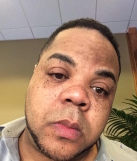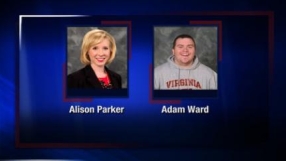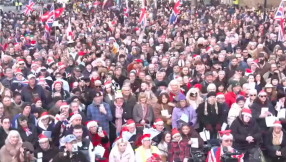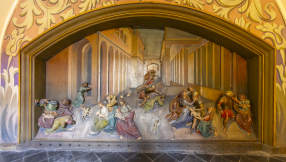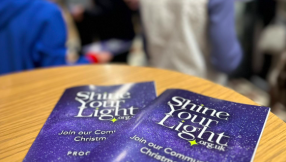Dateline: 12.30pm, Friday 22 November, 1963. This was before Rupert Murdoch bought The Sun, before the internet, before the age of mob justice by social media.
The place where President Kennedy was assassinated had not been considered important enough to have live television crews stationed there. But there were other cameras and crews along this part of the route and footage soon appeared, including photographs.
One Polaroid shot was snapped a sixth of a second after the fatal head shot that killed the president. The woman claimed afterwards she had been close enough to hear Jackie Kennedy cry out. A recent attempt to sell the photograph failed when it didn't meet its reserve at auction.
"Don't shoot the messenger," journalists say, usually meaning it metaphorically. Reporters the world over are shot and murdered regularly, but usually in war and terror zones. This time, the two journalists were shot by one of their own, a disgruntled former employee of the TV station. Outrage and distress has followed, not just at the shootings but also at the decision by some newspapers to put photographs of a dramatic moment before the murders on their front pages. Because the video footage from some of the still photographs were taken came from the shooter's own camera, and had been uploaded by him onto social media, some critics condemned this as "letting the killer tell the story".
The New York Daily News showed successive still frames of the shooting. But most of the outrage seems to be over the UK press. The Sun showed the moment the shot was fired. Other papers including The Times, Daily Telegraph, Daily Mail, Daily Mirror and Daily Star also carried vivid photographs. This prompted outrage on social media with many tweets to Ipso News, the industry's independent regulator, urging it to take action. Complaints are already being made under Clause 5 of the Editors' Code of Practice which covers intrusion into grief or shock, so this will be investigated.
In this there are no obvious innocent or guilty parties, apart from the victims and their murderer. Roy Greenslade in The Guardian noted: "It is fair to say that widespread public disgust at the publication of the pictures and the footage was matched by widespread public accessing of the same images."
There is nothing in the editors' code that specifically addresses the use of photographs in an incident such as this. Long debates take place in newsrooms about sensitive images. A tiny fraction of the gory horror of war, for example, appears in our newspapers. Photographs are assessed, used or rejected on the basis of such factors as the amount of blood in them, or whether they were taken before or after a person had been killed. Such photographs are never published gratuitously.
Arguments can be made for their publication when images capture evil and the consequences of evil. Publication can be said to be in the public interest. Nothing tells a story like a picture. Seeing those images of the horrified expression of that poor young woman must make anyone with a sliver of empathy want to weep. How could anyone do that? Murderers and would-be murderers need to be confronted with the dreadful truth of what they do. We all need to understand the consequences.
These arguments have to be balanced, however, against issues such as distress, identification of children or survivors, intrusion into grief and whether evil is being in any way exploited, for example, to generate sales.
The editors' code urges caution in giving too much detail about suicide, such as in case of copycat attempts.
There is another serious problem. Horrific images of all kinds appear regularly across new media. Anyone can put this material out there. Children in schools across the world should be taught something similar to the editors' code before being let loose on the internet.
Luke's Gospel gives us Jesus' famous warning about secrets: "Nothing is covered up that will not be revealed, or hidden that will not be known. Therefore whatever you have said in the dark shall be heard in the light, and what you have whispered in private rooms shall be proclaimed on the housetops." This was truly prophetic of our age. In the Bible there is also that difficult passage in Genesis, where Ham sees his drunken father Noah's nakedness. I've always thought it so unjust that it is not Noah who is condemned for getting drunk but Ham's descendants down the line of Canaan that are cursed forever for happening to see him in that state. But is this the Bible telling us of the dangers of intrusion? Perhaps Noah was more upset about the fact that Ham told his brothers than that he saw him in this vulnerable position. The story doesn't say.
There can be no more vulnerable moment in a person's life than the seconds before they die.
In our present age of social media, of trends and hashtags, there might be a case to be made for the editors' code to be expanded to take into account publishing material that takes into account this vulnerability, out of sensitivity for relatives. Guidance might also be considered on material that could incite copycat murders. Issues of privacy and intrusion have never been more complex as old and new media compete for advertising and sales. Yet at the same time, it does not need saying that newspapers must be free to fulfil their traditional roles as truth tellers.
The copycat concern is a real one. The killer seems to have been prompted partly by the South Carolina church massacre in June. There could easily be more mad gunmen out there, especially in the US where guns are so available. But there are problems over where such a line would be drawn. Violent video games would enter the equation if a step was taken in this direction. It could in the end prove impossible to judge when a picture would be deemed to be inciting, and when not. Freedom of speech must always be protected.
In publishing those pictures today it is possible a line was crossed, but if so it will have been crossed by mistake. The images that have caused offence are symptomatic of a wider problem than newspapers. When attacking the press, we must take care not to make the mistake of shooting a messenger. Those Kennedy photographs were and still are used with care. Criticising print newspapers for coverage of an incident is easy to do but there are terrible dangers of its own when this detracts attention from the incident itself, and what must be done to avoid repeat occurrences.
One story these pictures tell, a story that many just do not want to hear, is that almost anyone in the US can get a gun and a head camera and go and shoot someone with both of them. In the US in 2013, there were more than 11,000 gun murders and more than 84,000 non-fatal firearms injuries. That's one every 16 minutes, more than 90 a day. Of the 640 murders in the UK in 2011/2012, 44 involved a gun – under half the daily US toll of gun murders in a whole year.
The newspapers are simply telling it like it is. We have done this to the world, and if we don't like what we see in the mirror, we must not smash the mirror, but reflect responsibly and take action. The future of the mainstream media is uncertain in any case. Whether or not newspapers survive much longer to tell these stories, crazies with guns are out there, and will be for a long time to come.










